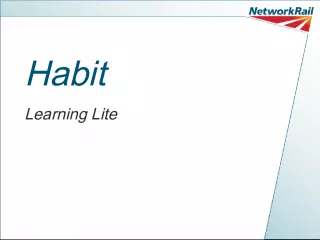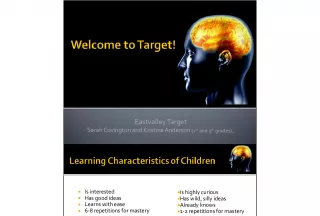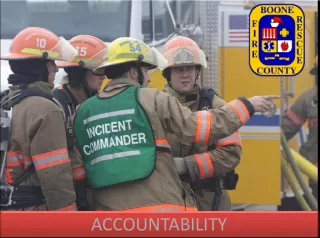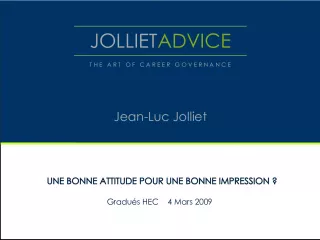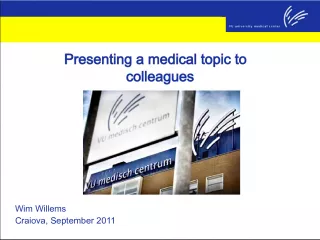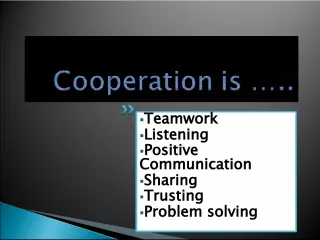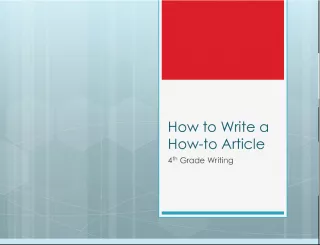Co TeachingIs what we are doing good for the bot
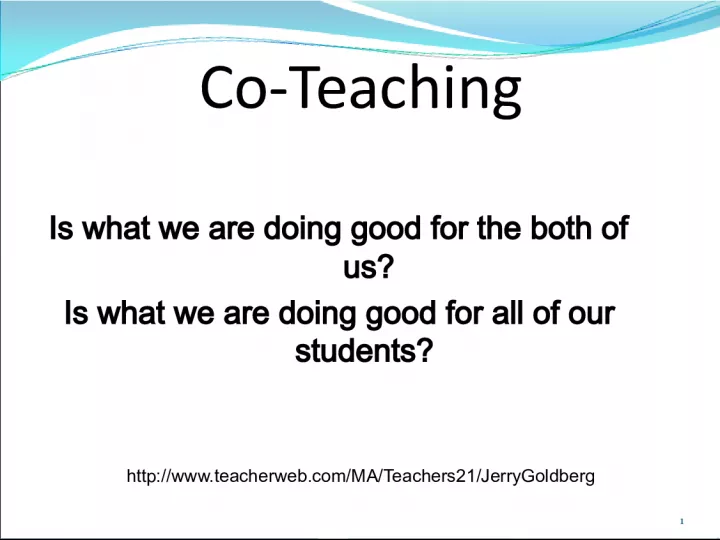

Co TeachingIs what we are doing good for the both of us Is what we are doing good for all of our students http www teacherweb com MA Teachers JerryGoldberg Every class has a variety of learners Every teache
- Uploaded on | 2 Views
-
 bennet
bennet
About Co TeachingIs what we are doing good for the bot
PowerPoint presentation about 'Co TeachingIs what we are doing good for the bot'. This presentation describes the topic on Co TeachingIs what we are doing good for the both of us Is what we are doing good for all of our students http www teacherweb com MA Teachers JerryGoldberg Every class has a variety of learners Every teache. The key topics included in this slideshow are . Download this presentation absolutely free.
Presentation Transcript
Slide1Co-TeachingIs what we are doing good for the both of us? Is what we are doing good for all of our students? http://www.teacherweb.com/MA/Teachers21/JerryGoldberg 1
Slide2Every class has a variety of learners… Every teacher is faced with the challenge of meeting the needs of a classroom filled with a variety of learners – their abilities, learning styles, motivation for learning. With a co-teacher, the possibilities of reaching all of those students increases exponentially. 2
Slide3“Educators must pulltogether by sharing their work through collaboration; too much knowledge and too many skills are needed for any single professional to keep up with and master all of them.” Marilyn Friend 3
Slide4Four key elements to co-teaching:1. Two or more professionals working together in a classroom. 2. Instruction occurs with the same physical space, which is typically the general education classroom 3. Sharing of teaching responsibilities 4. Instruction is provided to a heterogeneous group of students 4
Slide5Let’s chat… Benefits of co-teaching The research Selection and scheduling issues Barriers and cautions Assessment Student assessment Assessing the co-teacher relationship Change 5
Slide6collaborationinclusion teaming team teaching mainstreaming job sharing co-teaching 6
Slide7CollaborationAlthough it is generally preferred that co-teaching be collaborative, it might or might not be. Collaboration generally refers to how individuals interact, not the activity they’re doing. Thus, any activity—including co-teaching, and problem solving, consultation--may or may not be collaborative. 7
Slide8collaboration an ongoing process whereby professionalswith different expertise voluntarily work together to create solutions to problems that are impeding student’s success, as well as to carefully monitor and refine those solutions. Collaboration is enhanced by trust, respect, openness, and clear communication among the participants. Collaboration is a process rather than a specific service delivery model. - Knackendoffel 8
Slide9InclusionAlthough co-teaching is integral to the inclusive practices in many schools, it is not a requirement for inclusion to occur. Inclusion refers to a broad belief system or philosophy embracing the notion that all students should be welcomed members of a learning community, that all students are part of their classrooms even if their abilities differ. 9
Slide10Teaming or Team TeachingThe term team teaching is often used to describe the situation in which two general education teachers combine classes and share instruction. In an elementary school, this might occur when two fourth grade teachers decide to open the portable that divides their rooms and teach the entire group as one. In a secondary school, this might occur when an English teacher and a history teacher combine two classes to present an American studies course. Co-teaching is different from this type of team teaching in two important ways: First, in co-teaching the teacher-student ratio is drastically improved. Second, in co-teaching, two significantly different orientations toward teaching are blended. Finally, team teaching in the middle school literature often refers to a process for planning interdisciplinary instruction, but not sharing instructional delivery. 10
Slide11MainstreamingMainstreaming refers to the practice of educating students with special needs in regular classes during specific time periods based on their skill. This means regular education classes are combined with special education classes. Schools that practice mainstreaming believe that special needs students who cannot function in a regular classroom to a certain extent “belong” to the special education environment. 11
Slide12Job SharingJob Sharing is an employment arrangement where two people are retained on a part-time or reduced basis to fulfill the job normally performed by one person. Collaboration is implicit in the performance of the job to ensure that there is Continuity in the classroom. 12
Slide13Co-TeachingThat’s our job today – define co-teaching as it fits our needs. 13
Slide14 the nuts and bolts of co-teaching Co-teaching is a proactive approach to education. Co-teaching pairs general and special educators. Co-teaching takes place in heterogeneous, integrated settings. Co-teachers are simultaneously present in the classroom setting. Co-teachers maintain joint responsibility for classroom instruction. Co-teachers work in a coactive and coordinated fashion. Co-teachers design instruction to meet the needs of all students in the class. 14
Slide15What do you see when you observeco-teaching in action at Nissitissit? Nissitissit 15
Slide16Building a Culture for Co-Teaching Belief in a collaborative school culture Commitment to inclusive practices Understanding of co-teaching Visible reminders Assigning partners Observing implementation Professional development Problem solving when dilemmas occur Communicating beyond the school Letters to parents 16
Slide17marilyn friend’s definition of co-teaching includes these elements Co-teaching is a service delivery mechanism. Two or more professionals with equivalent licensure and employment status are the participants in co-teaching. Co-teachers share instructional responsibility and accountability for a single group of students for whom they both have ownership. Co-teaching occurs primarily in a shared classroom or workspace. Co-teachers’ specific level of participation may vary based on their skills and the instructional needs of the student group. 17
Slide18My characteristics……that are strengths for co-teaching …that could interfere with co-teaching Personal traits General understanding about schools and students Knowledge/skills related to my primary area of expertise 18
Slide19Time to Chat… Can the role of each co-teacher be defined at any given point in the lesson? Is each role meaningful and does it enhance the learning process? Is each teacher well-suited to the role(s) he or she is assuming? Are both teachers comfortable with process and content? What evidence is there that both teachers engaged in co-planning the lesson? What evidence is there that all students are being appropriately challenged? 19
Slide20Our Essential Question: What co-teaching models are best matched to our needs and those of our students? 20
Slide211 Teach, 1 Observe• One instructs, one observes and collects data • Roles should not be static • Teachers should create systematic method for taking down observations 21
Slide221 Teach, 1 ObserveBenefits Teacher can receive immediate feedback on his/her desired moves Cautions 22
Slide23Suggestions for One Teach/One Observe Modeling notetaking/writing instructions on board. Taking roll, following up with students who were absent in previous days. Collecting homework and scheduling help sessions for students who do not have it complete. Asking aloud questions students may feel shy about asking or questions needed for clarification. Proximity control Setting up materials for stations, labs Providing additional examples of work On-the-spot help for students who struggle during work time. Implementing accommodations, assistive tech 23
Slide24WHEN TO USE• In new co-teaching situations • When questions arise about students • To check student progress • To compare target students to others in class AMOUNT OF PLANNING • Low SAMPLE APPLICATIONS • Which students initiate conversations in cooperative groups? • Which students begin/do not being work promptly? • Is Anne’s inattentive behavior less, about the same, or greater than that of other students in the class? • What does James do when he is confused during an assignment? OTHER COMMENTS • If you use blank NCR form or carbon paper, you can make two copies of your data at once--and share immediately. • Once you’re experienced co-teachers with a mutual sense of comfort, observation of each other can serve as a form of coaching. 24
Slide25Station Teaching• Divide and concur • Students rotate around stations • Teachers offer support to all students 25
Slide26Station TeachingBenefits Cautions 26
Slide27WHEN TO USE• When content is complex but not hierarchical • In lessons in which part of planned instruction is review • When several topics comprise instruction AMOUNT OF PLANNING • Medium SAMPLE APPLICATIONS • During language arts instruction when one station will address comprehension of a recently-read piece of literature, one station will focus on editing of a writing assignment, and one station will consist of an activity related to a skill being taught. • In social studies to examine the geography, economy, and culture of a region or country. • In math, to teach a new process while reviewing applications of other concepts already presented. OTHER COMMENTS • Variations of station teacher, carried out across two days, are sometimes more appropriate in secondary settings with traditional class periods. • If students cannot work independently, two groups can be formed. If a student teacher is available, four groups might be arranged. 27
Slide28Parallel Teaching• joint planning • Split the class into two heterogeneous groups • Diversity in both groups 28
Slide29Parallel TeachingBenefits Cautions 29
Slide30 WHEN TO USE • When a lower adult-student ratio is needed to improve instructional efficiency • To foster student participation in discussions • For activities such as drill and practice, re-teaching, and test review AMOUNT OF PLANNING • Medium SAMPLE APPLICATIONS • More students would have a chance to share their alternative ending to the story if they are split into two groups. • If each teacher took a group of students and presented environmental issues--one from the point of view of business and industry and one from the point of view of environmentalists—the class could later have a spiritedly discussion on the topic. • Student use of the science materials could be more closely monitored if the group is divided in half. OTHER COMMENTS • This approach gives each teacher an active--but separate--instructional role in the classroom. • Any topic with multiple dimensions can be presented using this approach if the groups are then brought back together for discussion. • Students can be strategically placed in the two groups. 30
Slide31Alternative Teaching• Small group of students receives separate instruction • Teachers’ roles should not be static • Small group membership and composition should be fluid 31
Slide32Alternative TeachingBenefits Cautions 32
Slide33WHEN TO USE• In situations where students’ mastery of concepts taught or about to be taught varies tremendously • When extremely high levels of mastery are expected for all students • When enrichment is desired • When some students are working in a parallel curriculum AMOUNT OF PLANNING • High SAMPLE APPLICATIONS • The large group completes a practice exercise related to the concepts just taught; the small group receives additional direct instruction • The large group checks homework; the small group is pre-taught vocabulary related to the day’s lesson • The large group is working on projects in small groups; the small group is being assessed. All students will be assessed across two days. OTHER COMMENTS • For this approach to be successful, the purpose for the small group and its membership should vary. 33
Slide34Teaming• Both teachers are responsible for planning and share in the instruction of all students 34
Slide35TeamingBenefits Cautions 35
Slide36Suggestions for Routine Involvement by SpedTeacher in Team Teaching Taking charge of daily warm up/review, priming background knowledge Connecting new content to Big Idea Unit Overview Vocabulary Word Wall/notebook Cooperative Learning Process Specialist Creating/demonstrating models/examples of larger assignments or projects Modeling self-talk, self-instruction Directly teach and reinforce study skills 36
Slide37WHEN TO USE• When two heads are better than one or experience is comparable • During a lesson in which instructional conversation is appropriate • In co-teaching situations in which the teachers have considerable experience and a high sense of comfort • When a goal of instruction is to demonstrate some type of interaction to students AMOUNT OF PLANNING • High SAMPLE APPLICATIONS • In science, one teacher explains the experiment while the other demonstrates using the necessary materials. • In social studies, the teachers debate U.S. foreign policy issues. • In language arts or English, the teachers act out a scene from a piece of literature. • As the steps in a math process are taught, one explains while the other does a “Think Aloud” activity. • One teacher talks while the other demonstrates note-taking on the board or an overhead projector. OTHER COMMENTS • This co-teaching approach is affected more than any other by individuals’ teaching styles. • This is the most interpersonally complex co-teaching approach. 37
Slide38One Teaching, One Assisting• one teacher teaches while the other supports in instructional process 38
Slide39One Teaching, One AssistingBenefits Cautions 39
Slide40WHEN TO USE• When the lesson lends itself to delivery by one teacher • When one teacher has particular expertise for the lesson • In new co-teaching situations--to get to know each other • In lessons stressing a process in which student work needs close monitoring AMOUNT OF PLANNING • Low SAMPLE APPLICATIONS • “This is my absolute favorite lesson to teach. Am I wrong to want to teach it myself?” • How well do the students understand the steps to follow in long division? • Are all students following as they learn how to take notes? • “I’ve never taught geometry or worked with this teacher. I need to get a sense of the flow of the class.” OTHER COMMENTS • This approach is not particularly useful to help focus student attention. Instead, it has the risk of distracting students during large-group instruction. • Each teacher should have the opportunity to lead instruction and assist if this approach is used. 40
Slide41Reflection What are the five most important points that have been made during the just-completed segment of the workshop? a. b. c. d. e. Based on the information most critical to you, what points do you wish to remember to take back to school to share with others? a. b. c. d. e. 41 What are the questions or concerns you have (for the workshop group or colleagues at school) you have at this time?
Slide42Co-Teaching Benefits Lower teacher – student ratio Classroom of diverse learners Teachers can respond effectively to varied needs of students Another professional can provide different viewpoints and more ideas for instruction Teachers can be motivational for one another Co-teaching can positively affect the general educator’s instructional behavior 42
Slide43Barriers/Cautions Lack of administrative support Lack of shared planning time Need for in-service training Personality matches – the relationship between co- teachers is critical to success Misguided perceptions and/or lack of communication Poorly defined roles / unclear expectations Dividing the class based on SPED and non-SPED students 43
Slide44 “Virtually every treatise on inclusivepractices…concludes that inclusion’s success, in large part, relies on collaboration among staff members and with parents and others, and that failures can typically be traced to shortcomings in the collaborative dimension of the services to students.” Friend, 2000 44
Slide45Pet PeevesWhat are your pet peeves about teaching and learning and how might they influence a positive co- teaching experience? 45
Slide46Guidelines for Co-Teaching1. not evaluative 2. share an understanding of goals 3. Supportive – analyze what might have contributed to this outcome 4. interactions confidential 5. focus can change to meet the needs of the teachers 6. emphasizes probing questions as opposed to directive suggestions 7. opportunities to engage in planning as well as reflection 8. parity 46
Slide47Classroom and Behavior Management Considerations Learning environment Use of space for instruction Noise – strategies for keeping noise at an acceptable level Organizational routines Procedures for substitute teachers Classroom Norms (rules) Discipline procedures 47
Slide48Five Fears1. Fear of MAKING MISTAKES 2. Fear of LOOKING LIKE A FOOL 3. Fear of HAVING A WEAKNESS EXPOSED 4. Fear of NOT BEING LIKED 5. Fear of FAILURE Fears spring from beliefs! 48
Slide49Honest, Open Communication The lynchpin of a strong culture. It doesn’t mean saying just what is on your mind. It means creating the conditions, so others can say what they are thinking ( straight talk ) where people can be listened to, and when necessary, disagree agreeably (non-defensive) where administrators and teachers learn to read and understand how emotions impact working relationships and performance (self-awareness and social awareness) Where everyone takes responsibility for the mistakes they make, thus improving the chances to learn from them. 49
Slide50Safe TalkStraight Talk Hints at the real issue and is often unspecific, non-instructive Accurately saying what needs to be said to whom it needs to be said, at the time it needs to be said Begins with a goal to not hurt or be hurt Behaviorally specific, goal-focused and compassionate Focused on avoiding discomfort and/or conflict Sensitively timed, usually “in the moment” Rarely proactive and rarely supported by meaningful data Objectively serves the speaker, the listener, the organization Hints at the real issue and is often unspecific, non-instructive Accurately saying what needs to be said to whom it needs to be said, at the time it needs to be said 50
Slide51Following are some co-teaching scenarios that require straight talk. Keep in mind as you consider solutions: What is the problem? What is getting in the way of the collaboration? What suggestions do you have for addressing the issue? How will you start the conversation? What will you respond? What will you do next? 51
Slide52Case Study #1 Ben and Letitia are co-teaching in an eighth grade social studies class. Letitia is a very experienced social studies teacher, has been as this particular middle school for awhile, and is looked up to by her peers. Ben is a newly certified special education teacher, and while enthusiastic, is learning a lot this year about the entire set of responsibilities expected of a special education teacher. They discussed how they would work together at the beginning of the year and determined how Ben would participate in the instructional planning and teaching process. But as the year has progressed and gotten progressively busier, Letitia has asked Ben to be a "helper" of particular students, and to do many clerical tasks. How do they change this situation, which neither is particularly happy with, but seems to have settled into a routine? 52
Slide53Worksheet… Here are the issues: Here is what I think should be done: 53
Slide54Case Study #2 Margaret and Lauren have been co-teaching in a high school English class for one year. Margaret (the general education teacher) has been teaching three years and Lauren (the special education teacher) about the same, but only one year in the same building as Margaret. They have never actually designated a time to plan because this one co-taught class is the only time that their schedules overlap. Therefore, while there are substantially different student needs, Lauren follows Margaret's lead in what she had planned for the day. Little differentiated instruction is occurring. Therefore, while they have certainly found that two people are better than one for getting around to students, these teachers have not fully utilized the different expertise that they possess. 54
Slide55Worksheet… Here are the issues: Here is what I think should be done: 55
Slide56Case Study #3 Renee and Nicole have been very good friends ever since they started at teaching five years ago. They have been co-teaching together in Renee's math class since they came. They love this arrangement and look forward to their time together. However, the positive relationship between the teachers is the primary focus of the co-teaching program. They enjoy units that they've created together, as well as the strategies for implementing them. The problem that has arisen is that the principal would like to see Nicole co-teaching in other classrooms where significant student needs have appeared. Nicole is resisting doing this, because she doesn't want to change her comfortable and enjoyable teaching situation. She is one of the special education teachers in her building. 56
Slide57Worksheet… Here are the issues: Here is what I think should be done: 57
Slide58Case Study #4 Marcus and Toby are co-teaching in a 9th grade English class. Marcus has taught in the English department at this high-school for 25 years. Toby has taught Special Education (primarily in Learning Centers) for 15 years, the last 10 in this high-school. There is and has been resistance from teachers in the English department to participate in this school-wide effort to provide sections of co-taught classes in all the core areas. Marcus and Toby have been reluctant partners for half the school year and are making a case to their respective department heads to pull students with IEPs out of the section and teach them in a separate section in the Learning Center. Little effort has gone into co-planning and coordinating instruction between the two teachers. Toby has taken a "hands off" approach because she perceives Marcus to be unwilling to change; Marcus feels he knows how to teach English well, and that some students just shouldn't be in general education classes if they do not put forth the "effort". 58
Slide59Worksheet… Here are the issues: Here is what I think should be done: 59
Slide60Case Study #5 Ellen is a middle school teacher in an urban school district in a school with many "at risk" students. She has been there for two years. Alden in a new special education teacher in the district with an emergency certificate in teaching. She has started a Special Education teacher education program at a local university, but can only take one class each semester. Learning "on- the-job" describes her situation aptly. Ellen and Alden are co-teaching during the language arts block. While there are two teachers in the classroom, Ellen often feels that Alden is as needy as her students. She also feels that she is barely above water herself in learning the curriculum and addressing the needs of the students. Alden feels the same. How can these two teachers turn this novice learning experience into one that works for students and assists them (the teachers) in learning the instructional skills that they obviously do not have yet and need to be successful with many students "at risk" or with special needs? 60
Slide61Worksheet… Here are the issues: Here is what I think should be done: 61
Slide62Finding Time for Collaboration Most professionals express concern about the time needed to form collaborative working relationships with their colleagues, particularly for activities such as co-teaching. They also worry about setting realistic expectations regarding time for collaboration. Although there is no secret to enable you to make more minutes in the day, there are some ways professionals can make the most of the time they do have available. 62
Slide631. Have two classes team to release one teacher (e.g., two English teachers, a social studies teacher and an English teacher, a math teacher and a science teacher). 2. Use other adults to help cover classes--including principals, assistant principals, counselors, social workers, volunteers, paraprofessionals, psychologists, and supervisors. Of course, be sure to follow local policies on who can supervise groups of students. 3. Find funds for substitute teachers--some sources include grants from your state or local foundations, parent-teacher organizations, and disability advocacy groups. 4. Find “volunteer” substitutes--retired teachers, members of social or civic organizations, teacher trainees from local universities 5. Use instructionally relevant videotapes or other programs supervised by part of the staff to release the other part of the staff for planning. 63
Slide646. When school-based staff development sessions are scheduled, arrange for them to begin late or conclude early with the saved time being used to collaboration. 7. Experiment with a late arrival or early dismissal day. This time can occur once per week, once per month, or once per grading period. Typically, the school day is lengthened and the additional minutes are “banked” to provide the release. The time thus created must be used in working with colleagues. It is not additional individual preparation time nor is it time to be spent on large-group, formal meetings. 8. Stay late after school once per month, but make it enjoyable by bringing snacks, flowers, music, or other pleasant “atmosphere” items. If you bring walking shoes, you can accomplish both exercise and collaboration! 9. Treat collaboration as the equivalent of school committee responsibilities, especially if you are operating a pilot program. Time that others in school spend in committee meetings is spent working collaboratively. 10.Divide labor for instruction to save time. That is, have each teacher take the lead for preparing materials for different lessons, making enough copies for all involved. 11. Reduce other work to have time to meet--for example, have students correct each others’ work or create self-correcting materials. 12. For special educators, reserve time in the daily schedule that is not obligated to specific responsibilities. Use this time flexibly with lunch, planning, and other time to meet with teachers. 64
Slide65Reflection65

